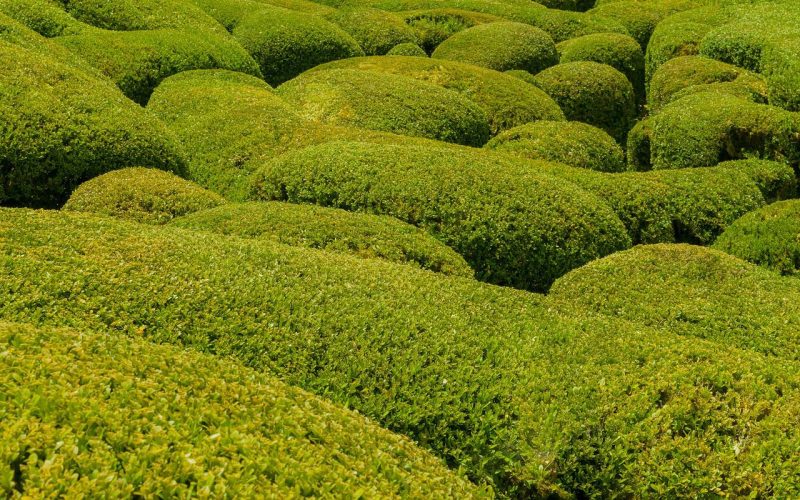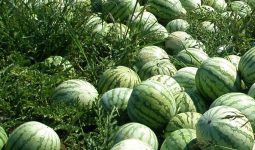Discover the various types of boxwood you can use in your formal or informal garden for that wow factor as you learn more about the most common landscaping bush.
Boxwood shrubs are among the most adaptable plant species in the plant kingdom. They are evergreen shrubs that maintain their green foliage throughout the year.
The landscape of your lawn can use these shrubs for various purposes, both in terms of form and function.
Boxwoods are available in a range of forms, dimensions, and densities. In actuality, there are over 365 different varieties and about 90 different species.
These shrubs can do almost anything in your yard, thanks to their wide varieties.
Boxwood plants are excellent for defining areas around your home because they respond well to shaping and shearing.
You can build a privacy hedge impervious to wildlife intrusion along the property line.
Without much ado, let’s discuss some different types of boxwood.
1. English Boxwood
Due to its slow growth, English boxwood is sometimes called dwarf boxwood.
However, despite its slow growth, English boxwood is a highly fashionable and sophisticated evergreen shrub that can add beauty to any landscape.
English boxwood is found in several upscale locations, including the White House and the colonial gardens of Williamsburg, Virginia.
The shrub is prized for its gorgeous, round, densely packed, light-green leaves. At maturity, the plant can grow to three feet; however, different varieties frequently have different growth sizes. Pruning can maintain all different types of English boxwoods.
Furthermore, English boxwood’s shallow roots require protection from extreme heat. A layer of garden mulch should be placed around the plant for protection. However, be careful not to mulch the bush’s trunk, which could attract unwanted pests.
2. American Boxwood
American boxwood, also known in science as Buxus Sempervirens, is a glossy, dark-green, evergreen shrub that requires little maintenance and is resistant to pests and diseases.
Also, American boxwood, also known as common boxwood, can reach heights of up to 10 feet; some varieties can even reach 20 feet.
American boxwood is a dark green shrub that may suit people in colder or cooler climates because it can withstand shallow temperatures and strong winds. The fact that these bushes frequently withstand drought is even more impressive.
Even though the hardy American boxwoods resist many diseases, they occasionally prey on root rot, canker, and nematodes.
3. Dee Runk Boxwood
Dee Runk, known by its botanical name Buxus sempervirens, is a narrow, upright-growing evergreen shrub with broad leaves. The tall plant can grow up to 10 to 12 feet tall and has oval-shaped, dark green leaves.
This shrub can be used in an enclosed area, such as the front or back of the house. It is ideal if the owner prefers partial shade or full sun. This is one of the different types of boxwood.
4. Fastigiate Boxwood
This shrub has dense, dark-green foliage and is evergreen. Its tiny, glossy, oval leaves typically stay dark green all year. The shrub develops a pyramidal shape that attracts bees.
Despite this, deer tend to avoid such shrubs, so the plant is unpopular. Fastigiata boxwood is the best choice for hedges or screening. The best part is that it coexists peacefully with other nearby plants.
5. Vardar Valley Boxwood
It grows naturally on rocky hillsides and in wooded areas as a small, rounded tree. The evergreen plant tends to reach the height of a massive tree.
The shrub develops elliptical, oval, and oblong-shaped leaves as it ages. Vardar Valley’s leaves are dark green, like other American boxwoods.
Make sure to grow this glossy shrub in moist soil with a pH balance of slightly acidic. It is best to prune the shrub in the early spring because it is pruning tolerant.
This will encourage the healthy growth of new leaves that the previous spring’s frost might have killed. Also, the plant requires additional protection during winter because mites may attack it.
6. Japanese Boxwood
Japanese boxwood (Buxus Microphylla), a little leaf box, is an evergreen shrub with a slow growth rate similar to English boxwood. Despite its slow growth, the shrub can withstand pruning and is suitable for engraving.
Since this hardy plant remains evergreen from April through May, its blooming season coincides with spring.
This full-rounded plant has striking green leaves resembling a low hedge in full bloom. The shrub also has male and female flowers, and flies and bees pollinate it.
Furthermore, ensuring the soil is well-drained and has an acidic pH level is essential for the healthy growth of Japanese boxwoods.
When wet, the foliage has a strong, overpowering, pungent smell. The plant grows well in full sun and partial shade; the only requirement is moist soil.
Furthermore, it is a low-maintenance plant that only needs the occasional cleaning. Because it grows slowly, you won’t need to prune as often.
Depending on how neatly manicured the owner wants their shrub to be, pruning should ideally be done once or twice a month.
Also, water the plant regularly, but give it time to dry out between waterings. Do not forget to fertilize three times per year. This is one of the different types of boxwood.
7. Green Beauty Boxwood
This is an excellent option for tiny hedges. The best feature of green beauty boxwood is that it keeps its dark green foliage even during the hottest summer months. Green beauty boxwoods are more drought and humidity-tolerant than other boxwoods.
This evergreen hedge needs some to all of the sun for healthy growth. It develops moderately, reaching heights and widths of 4 to 6 feet.
Green beauty has a variety of landscaping applications; for instance, the shrub is suitable for highlighting entrance areas and foundation beds.
The dark green gem can also create a lovely fence or border. It’s thick vegetation shelters birds and small animals.
8. Morris Midget Boxwood
This is a small, dwarf boxwood with extremely dense evergreen foliage. This boxwood variety is best for growing a low hedge or an edge for walkways and gardens.
Dwarf hedge plants require regular watering and partial to full sun for full growth, just like green beauty boxwood.
Morris midgets have a slow growth rate and can reach heights and widths up to 12 inches and 18 inches, respectively. The following are some recommended companion plants: spirea, maiden grass, coneflower, lilac, and gayfeather.
9. Morris Dwarf Boxwood
Morris dwarf is a slow-growing plant that can reach heights of one to two feet and widths of one to two inches.
Also, Morris dwarf is a low-maintenance plant that only needs occasional watering because it is a small yellowish-green shrub. However, the plant requires moist, well-drained soil that is partial to full sun.
Furthermore, remember that this tiny plant is insect-resistant and has a hardiness range of 5 to 8. This is one of the different types of boxwood.
10. Korean Boxwood
Korean boxwoods are broadleaf evergreen plants with an upright growth habit that reach a height of about 2 feet. Their botanical name is Buxus Sinica Insularis.
The shrub’s shape tends to widen rather than get taller as it ages and develops an open-branch structure. They are very dense plants with evergreen leaves like many other boxwoods.
Again, Korean boxwoods are striking to look at in the summer when their leaves are a deep, rich green. In the winter, they usually take on a more bronze hue.
The shrub produces scented, cream-colored blossoms in the spring, which bees use to pollinate the flowers. By the time fall arrives these flowers have transformed into seed capsules.
Korean boxwood is a cold-hardy shrub that can easily withstand harsh winters down to USDA hardiness zone 4. It’s crucial to pick a location with moist, loamy soils that receive some sunlight.
The evergreen foliage might require defense against desiccation, which occurs when there is no moisture during the winter.
Therefore, growing Korean boxwoods in areas that can shield them from chilly winter winds is crucial. Otherwise, they risk getting burned by the winter.
Also, this particular variety of boxwood makes an excellent hedge or border plant. To maintain its green foliage, you will need to prune it. Never be afraid to clip it into shape when required.
11. Green Gem Boxwood
Green gem boxwood, referred to as Buxus, is an evergreen shrub with broad leaves that typically blooms in the spring.
The plant thrives in well-drained soil, medium moisture, a little acidic, and partially to completely shaded. The evergreen shrub, which can reach a height and width of 3 to 4 feet, is prized for its rounded shape.
Avoid growing the shrub close to other plants or with shallow roots because wind circulation could harm the shrub.
Furthermore, this plant needs to be grown in a protected area in USDA Zones 4 and 5 to avoid being damaged by strong winds during the winter.
Cover the shrub in the winter to prevent snow from building up on the stems and branches. This is one of the different types of boxwood.
12. Glencoe Boxwood
Glencoe boxwood, also called Chicagoland Green Boxwood, is an evergreen shrub that retains its gleaming green foliage all year round.
The plant is considered to be cold-hardy because of this. Also, this particular variety of boxwood resembles English boxwoods because both have the ideal oval low hedge.
Furthermore, regular watering is necessary for the dark green plant, especially during intense heat. This small shrub can grow to a maximum height and width of 3 to 4 inches. The lovely shrub produces white blossoms this spring, drawing many birds.
13. Green Mound Boxwood
The green mound is a different type of boxwood, a low hedge shrub with oval-shaped, medium-sized leaves.
The admirable quality of this plant is that its foliage stays green all year. This boxwood is tolerant of pruning, and shearing is another fantastic quality.
Furthermore, the boxwood variety needs full shade and some sunlight to grow. Avoiding direct sunlight is crucial, as this may cause winter scorch or mite infestations on the plant’s foliage. This is one of the different types of boxwood.
14. Green Velvet Boxwood
This boxwood has a dense body and is ideal for low hedges. Like green mound boxwood, it maintains its original green hue all winter. The best part is that it requires little upkeep, neither routine watering nor trimming.
Lilac, maiden grass, weigela, and coneflower are companion plants that enhance green velvet boxwood. A beautiful round evergreen adds rich color, texture, and structure to any garden.
Without the addition of beautiful boxwood, any landscape design in contemporary construction is lacking. The best way to improve these planned spaces is to have them in the garden, backyard, porch area, front lawn, or driveways.








